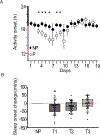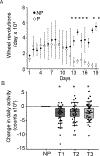Pregnancy Induces an Earlier Chronotype in Both Mice and Women
- PMID: 31018734
- PMCID: PMC7408307
- DOI: 10.1177/0748730419844650
Pregnancy Induces an Earlier Chronotype in Both Mice and Women
Abstract
Daily rhythms generated by endogenous circadian mechanisms and synchronized to the light-dark cycle have been implicated in the timing of birth in a wide variety of species. Although chronodisruption (e.g., shift work or clock gene mutations) is associated with poor reproductive outcomes, little is known about circadian timing during pregnancy. This study tested whether daily rhythms change during full-term pregnancies in mice and women. We compared running wheel activity continuously in both nonpregnant ( n = 14) and pregnant ( n = 13) 12- to 24-week-old C57BL/6NJ mice. We also monitored wrist actigraphy in women ( N = 39) for 2 weeks before conception and then throughout pregnancy and measured daily times of sleep onset. We found that on the third day of pregnancy, mice shift their activity to an earlier time compared with nonpregnant dams. Their time of daily activity onset was maximally advanced by almost 4 h around day 7 of pregnancy and then shifted back to the nonpregnant state approximately 1 week before delivery. Mice also showed reduced levels of locomotor activity during their last week of pregnancy. Similarly, in women, the timing of sleep onset was earlier during the first and second trimesters (gestational weeks 4-13 and 14-27) than before pregnancy and returned to the prepregnant state during the third trimester (weeks 28 until delivery). Women also showed reduced levels of locomotor activity throughout pregnancy. These results indicate that pregnancy induces changes in daily rhythms, altering both time of onset and amount of activity. These changes are conserved between mice and women.
Keywords: chronodisruption; chronotype; circadian rhythm; delivery; locomotor activity; pregnancy.
Conflict of interest statement
Declaration of Conflicting Interests
The authors have declared no conflicts of interest
Figures



References
-
- Albers HE, Gerall AA & Axelson JF (1981) Effect of reproductive state on circadian periodicity in the rat. Physiol Behav 26, 21–5. - PubMed
-
- Amaral FG, Castrucci AM, Cipolla-Neto J, Poletini MO, Mendez N, Richter HG & Sellix MT (2014) Environmental Control of Biological Rhythms: Effects on Development, Fertility and Metabolism. Journal of Neuroendocrinology 26, 603–12. - PubMed
-
- Brunner DP, Munch M, Biedermann K, Huch R, Huch A & Borbely AA (1994) Changes in sleep and sleep electroencephalogram during pregnancy. Sleep 17, 576–82. - PubMed
-
- Chong CSY (2018) Disorders of sleep and circadian rhythms. Handbook of Clinical Neurology 148, 531–8. - PubMed
Publication types
MeSH terms
Grants and funding
LinkOut - more resources
Full Text Sources
Other Literature Sources
Medical

